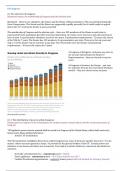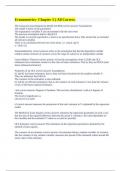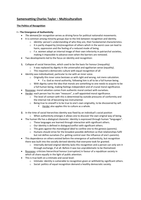US Congress
2.1 The structure of Congress
Bicameral nature, the membership of Congress and the election cycle
Bicameral – there is two chambers, the Senate and the House of Representatives. This was decided during the
Great Compromise. The Senate and the House are supposedly equally powerful, but it could easily be argued
that in the 21st century the Senate is more powerful
The membership of Congress and the election cycle – there are 435 members of the House as each state is
represented by the population that their state has (dependent on census every 10 years), and each state has to
have at least 1 representative. Members serve for two years. Constitutional requirements – 25 years old, citizen
of the USA for 7 years. The Senate has 100 members, 2 representatives per state. They serve for six years and
only 1/3 of the Senate can be voted for at any time. The VP presides over the Senate. Constitutional
requirements – 30 years old, citizen for 9 years
A Congress of delegates: (someone you elect to
act on your instructions) the House of
Representatives – they are elected every two
years
A Congress of trustees: the Senate – you vote
for someone because you trust them (Burkean
model) – they are elected every six years
2.1.1 The distribution of powers within Congress:
Powers given to Congress in the Constitution, the exclusive powers of each House and the concurrent powers of
Congress
"All legislative powers herein granted shall be vested in a Congress of the United States, which shall consist of a
Senate and a House of Representatives."
- Article I US Constitution
The US Constitution establishes the powers which Congress has, some of them are specific, the power “to coin
money” others are more general in scope, “to provide for the general welfare of the US”. Certain powers are
exclusive to one house and others are concurrent. Your task is to decide which are concurrent and which are
exclusive.
- Override a Presidential veto – concurrent power - JASTA
- Pass Legislation – concurrent power – The Taxes and Jobs Act 2017
- Confirm Presidential appointments – exclusive Senate power, Merrick Garland for Attorney General
, - Ratify treaties – exclusive Senate power. Obama achieved ratification of the START treaty in 2010, a
deal with Russia to scale back nuclear arsenals. There was a Senate rejection in 2012, of an Obama-
backed treaty on disabled rights, which gained the support of only 61 Senators. Joint Comprehensive
Plan of Action – Iran nuclear deal
- Initiate Finance Bills – exclusive House power. Every year the budget, known as the Finance Act which
will start in the House. 2022 Annual Budget. Taxes and Jobs Act 2017
- Impeach (to accuse) – exclusive House power. Three US presidents (Andrew Johnson in 1868 and Bill
Clinton in 1998 and Donald Trump) and one Supreme Court justice (Samuel Chase in 1804) have been
impeached
- Initiate Constitutional Amendments – concurrent power
- Declare War – concurrent power. Congress approved its last formal declaration of war during World
War II – December 8th 1941
- Try Impeachment Cases – exclusive Senate power. Clinton was impeached but not removed from office,
mainly because of the result of the midterm elections in 1998, which saw the Democrats increase their
share of seats in the House. The Republican failure to gain seats in the Senate was largely seen as public
reaction against the ongoing Republican pursuit of Bill Clinton over the Lewinsky affair. Johnson and
Chase survived the attempt to remove them in the Senate. Donald Trump – not found guilty
- Elect a Vice President if the electoral college is deadlocked – exclusive Senate power, never happened
- Elect a President if the electoral college is deadlocked – exclusive House power, never happened
- Confirm a newly appointed Vice President – concurrent power, 1973 – Spiro Agnew was VP and he
was involved in financial conduct so he resigned, Gerald Ford replaced him as VP
2.2 The functions of Congress
2.2.1 Representation
Congressional elections and the significance of incumbency; factors that affect voting behaviour within Congress
(parties and caucuses, constituency, pressure groups, lobbyists and polarisation)
Congressional elections
1) High Numbers of Safe Seats
It is no accident that since 2010 there has been relatively little consensus between Democrats and Republicans
on Capitol Hill, resulting in gridlock on such vital issues as immigration reform, gun control, and, most
damaging of all, the budget and the debt ceiling.
One startling consequence of safe seats is that some seats go uncontested. In 2014:
- The Republicans secured 15 ‘acclaimed’ seats - in other words there was no opposition; examples
include 4 seats in Georgia, 3 in Florida and 2 in Pennsylvania. This compares to 8 in 2012.
- In 18 other seats there were only independent candidates, no Democrat. So in total, the Republicans
faced no Democratic opposition in 33 seats. Of these 6 were in Texas.
- The Democrats secured 16 acclaimed seats – including 3 in Georgia, 2 in Florida and 6 in
Massachusetts; this compares to 4 in 2012.
- In 16 other seats there were only independent candidates and no Republican. Of these 7 were in New
York and 6 in Texas. Thus in total, the Democrats faced no Republican opposition in 32 seats
- In 2016 the figures were little better. The Democrats faced no Republican competition in 25 seats; the
Republicans faced no Democratic opposition in 28 seats; the worst state for this was Texas,
where 10 of 36 congressional districts did not have a two-major party contest. In Massachusetts it was
5 out of 9. 18 states contained uncontested districts.
Was 2018 any different?
There were 3 House seats with no Democratic candidate and 38 seats with no Republican candidate; overall
total 41. The worst states for uncontested seats were California (no Republican in 8, no Democrat in 1 = 9) New
York (no Republican in 6) and Florida (no Republican in 5)
2) High Incumbent Re-election Rates
2.1 The structure of Congress
Bicameral nature, the membership of Congress and the election cycle
Bicameral – there is two chambers, the Senate and the House of Representatives. This was decided during the
Great Compromise. The Senate and the House are supposedly equally powerful, but it could easily be argued
that in the 21st century the Senate is more powerful
The membership of Congress and the election cycle – there are 435 members of the House as each state is
represented by the population that their state has (dependent on census every 10 years), and each state has to
have at least 1 representative. Members serve for two years. Constitutional requirements – 25 years old, citizen
of the USA for 7 years. The Senate has 100 members, 2 representatives per state. They serve for six years and
only 1/3 of the Senate can be voted for at any time. The VP presides over the Senate. Constitutional
requirements – 30 years old, citizen for 9 years
A Congress of delegates: (someone you elect to
act on your instructions) the House of
Representatives – they are elected every two
years
A Congress of trustees: the Senate – you vote
for someone because you trust them (Burkean
model) – they are elected every six years
2.1.1 The distribution of powers within Congress:
Powers given to Congress in the Constitution, the exclusive powers of each House and the concurrent powers of
Congress
"All legislative powers herein granted shall be vested in a Congress of the United States, which shall consist of a
Senate and a House of Representatives."
- Article I US Constitution
The US Constitution establishes the powers which Congress has, some of them are specific, the power “to coin
money” others are more general in scope, “to provide for the general welfare of the US”. Certain powers are
exclusive to one house and others are concurrent. Your task is to decide which are concurrent and which are
exclusive.
- Override a Presidential veto – concurrent power - JASTA
- Pass Legislation – concurrent power – The Taxes and Jobs Act 2017
- Confirm Presidential appointments – exclusive Senate power, Merrick Garland for Attorney General
, - Ratify treaties – exclusive Senate power. Obama achieved ratification of the START treaty in 2010, a
deal with Russia to scale back nuclear arsenals. There was a Senate rejection in 2012, of an Obama-
backed treaty on disabled rights, which gained the support of only 61 Senators. Joint Comprehensive
Plan of Action – Iran nuclear deal
- Initiate Finance Bills – exclusive House power. Every year the budget, known as the Finance Act which
will start in the House. 2022 Annual Budget. Taxes and Jobs Act 2017
- Impeach (to accuse) – exclusive House power. Three US presidents (Andrew Johnson in 1868 and Bill
Clinton in 1998 and Donald Trump) and one Supreme Court justice (Samuel Chase in 1804) have been
impeached
- Initiate Constitutional Amendments – concurrent power
- Declare War – concurrent power. Congress approved its last formal declaration of war during World
War II – December 8th 1941
- Try Impeachment Cases – exclusive Senate power. Clinton was impeached but not removed from office,
mainly because of the result of the midterm elections in 1998, which saw the Democrats increase their
share of seats in the House. The Republican failure to gain seats in the Senate was largely seen as public
reaction against the ongoing Republican pursuit of Bill Clinton over the Lewinsky affair. Johnson and
Chase survived the attempt to remove them in the Senate. Donald Trump – not found guilty
- Elect a Vice President if the electoral college is deadlocked – exclusive Senate power, never happened
- Elect a President if the electoral college is deadlocked – exclusive House power, never happened
- Confirm a newly appointed Vice President – concurrent power, 1973 – Spiro Agnew was VP and he
was involved in financial conduct so he resigned, Gerald Ford replaced him as VP
2.2 The functions of Congress
2.2.1 Representation
Congressional elections and the significance of incumbency; factors that affect voting behaviour within Congress
(parties and caucuses, constituency, pressure groups, lobbyists and polarisation)
Congressional elections
1) High Numbers of Safe Seats
It is no accident that since 2010 there has been relatively little consensus between Democrats and Republicans
on Capitol Hill, resulting in gridlock on such vital issues as immigration reform, gun control, and, most
damaging of all, the budget and the debt ceiling.
One startling consequence of safe seats is that some seats go uncontested. In 2014:
- The Republicans secured 15 ‘acclaimed’ seats - in other words there was no opposition; examples
include 4 seats in Georgia, 3 in Florida and 2 in Pennsylvania. This compares to 8 in 2012.
- In 18 other seats there were only independent candidates, no Democrat. So in total, the Republicans
faced no Democratic opposition in 33 seats. Of these 6 were in Texas.
- The Democrats secured 16 acclaimed seats – including 3 in Georgia, 2 in Florida and 6 in
Massachusetts; this compares to 4 in 2012.
- In 16 other seats there were only independent candidates and no Republican. Of these 7 were in New
York and 6 in Texas. Thus in total, the Democrats faced no Republican opposition in 32 seats
- In 2016 the figures were little better. The Democrats faced no Republican competition in 25 seats; the
Republicans faced no Democratic opposition in 28 seats; the worst state for this was Texas,
where 10 of 36 congressional districts did not have a two-major party contest. In Massachusetts it was
5 out of 9. 18 states contained uncontested districts.
Was 2018 any different?
There were 3 House seats with no Democratic candidate and 38 seats with no Republican candidate; overall
total 41. The worst states for uncontested seats were California (no Republican in 8, no Democrat in 1 = 9) New
York (no Republican in 6) and Florida (no Republican in 5)
2) High Incumbent Re-election Rates





